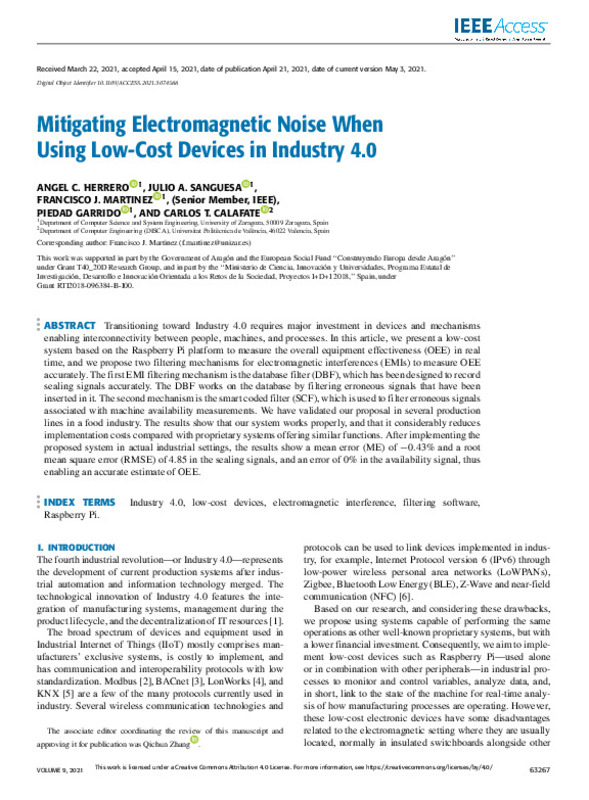Herrero, ÁC.; Sangüesa, JA.; Martínez, FJ.; Garrido, P.; Tavares De Araujo Cesariny Calafate, CM. (2021). Mitigating Electromagnetic Noise When Using Low-Cost Devices in Industry 4.0. IEEE Access. 9:63267-63282. https://doi.org/10.1109/ACCESS.2021.3074588
Por favor, use este identificador para citar o enlazar este ítem: http://hdl.handle.net/10251/183699
|
Título:
|
Mitigating Electromagnetic Noise When Using Low-Cost Devices in Industry 4.0
|
|
Autor:
|
Herrero, Ángel C.
Sangüesa, Julio A.
Martínez, Francisco J.
Garrido, Piedad

 Tavares De Araujo Cesariny Calafate, Carlos Miguel
Tavares De Araujo Cesariny Calafate, Carlos Miguel
|
|
Entidad UPV:
|
Universitat Politècnica de València. Departamento de Informática de Sistemas y Computadores - Departament d'Informàtica de Sistemes i Computadors
|
|
Fecha difusión:
|
|
|
Resumen:
|
[EN] Transitioning toward Industry 4.0 requires major investment in devices and mechanisms enabling interconnectivity between people, machines, and processes. In this article, we present a low-cost system based on the ...[+]
[EN] Transitioning toward Industry 4.0 requires major investment in devices and mechanisms enabling interconnectivity between people, machines, and processes. In this article, we present a low-cost system based on the Raspberry Pi platform to measure the overall equipment effectiveness (OEE) in real time, and we propose two filtering mechanisms for electromagnetic interferences (EMIs) to measure OEE accurately. The first EMI filtering mechanism is the database filter (DBF), which has been designed to record sealing signals accurately. The DBF works on the database by filtering erroneous signals that have been inserted in it. The second mechanism is the smart coded filter (SCF), which is used to filter erroneous signals associated with machine availability measurements. We have validated our proposal in several production lines in a food industry. The results show that our system works properly, and that it considerably reduces implementation costs compared with proprietary systems offering similar functions. After implementing the proposed system in actual industrial settings, the results show a mean error (ME) of -0.43% and a root mean square error (RMSE) of 4.85 in the sealing signals, and an error of 0% in the availability signal, thus enabling an accurate estimate of OEE.
[-]
|
|
Palabras clave:
|
Industry 4.0
,
Low-cost devices
,
Electromagnetic interference
,
Filtering software
,
Raspberry Pi
|
|
Derechos de uso:
|
Reconocimiento (by)
|
|
Fuente:
|
IEEE Access. (eissn:
2169-3536
)
|
|
DOI:
|
10.1109/ACCESS.2021.3074588
|
|
Editorial:
|
Institute of Electrical and Electronics Engineers
|
|
Versión del editor:
|
https://doi.org/10.1109/ACCESS.2021.3074588
|
|
Código del Proyecto:
|
info:eu-repo/grantAgreement/Gobierno de Aragón//T40_20D/
info:eu-repo/grantAgreement/AEI/Plan Estatal de Investigación Científica y Técnica y de Innovación 2017-2020/RTI2018-096384-B-I00/ES/SOLUCIONES PARA UNA GESTION EFICIENTE DEL TRAFICO VEHICULAR BASADAS EN SISTEMAS Y SERVICIOS EN RED/
|
|
Agradecimientos:
|
This work was supported in part by the Government of Aragon and the European Social Fund "Construyendo Europa desde Aragon" under Grant T40_20D Research Group, and in part by the "Ministerio de Ciencia, Innovacion y ...[+]
This work was supported in part by the Government of Aragon and the European Social Fund "Construyendo Europa desde Aragon" under Grant T40_20D Research Group, and in part by the "Ministerio de Ciencia, Innovacion y Universidades, Programa Estatal de Investigacion, Desarrollo e Innovacion Orientada a los Retos de la Sociedad, Proyectos I+D+I 2018," Spain, under Grant RTI2018-096384-B-I00.
[-]
|
|
Tipo:
|
Artículo
|









